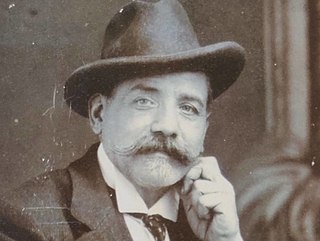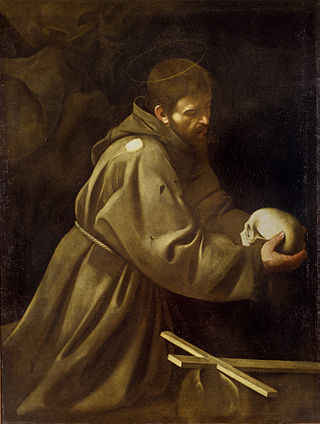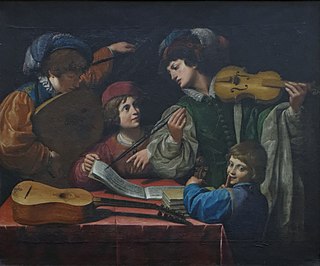
Michelangelo Merisida Caravaggio, known as simply Caravaggio, was an Italian painter active in Rome for most of his artistic life. During the final four years of his life he moved between Naples, Malta, and Sicily until his death. His paintings have been characterized by art critics as combining a realistic observation of the human state, both physical and emotional, with a dramatic use of lighting, which had a formative influence on Baroque painting.

The Caravaggisti were stylistic followers of the late 16th-century Italian Baroque painter Caravaggio. His influence on the new Baroque style that eventually emerged from Mannerism was profound. Caravaggio never established a workshop as most other painters did, and thus had no school to spread his techniques. Nor did he ever set out his underlying philosophical approach to art, the psychological realism which can only be deduced from his surviving work. But it can be seen directly or indirectly in the work of Rubens, Jusepe de Ribera, Bernini, and Rembrandt. Famous while he lived, Caravaggio himself was forgotten almost immediately after his death. Many of his paintings were re-ascribed to his followers, such as The Taking of Christ, which was attributed to the Dutch painter Gerrit van Honthorst until 1990.

Giuseppe Calì was a Maltese painter of Italian descent.

St John's Co-Cathedral is a Roman Catholic co-cathedral in Valletta, Malta, dedicated to Saint John the Baptist. It was built by the Order of St. John between 1573 and 1578, having been commissioned by Grand Master Jean de la Cassière as the Conventual Church of Saint John.

Giovanni Baglione was an Italian Late Mannerist and Early Baroque painter and art historian. Although a prolific painter, Baglione is best remembered for his encyclopedic collection of biographies of the other artists working in Rome during his lifetime, and particularly his acrimonious relationship with the slightly younger artist Caravaggio through his art and writings.

The Madonna of the Rosary is a painting finished in 1607 by the Italian Baroque painter Caravaggio, now in the Kunsthistorisches Museum in Vienna. It is the only painting by Caravaggio that could be called a standard Baroque altarpiece.

The Denial of Saint Peter(La Negazione di Pietro) is a painting finished around 1610 by the Italian painter Caravaggio. It depicts Peter denying Jesus after Jesus was arrested. The painting is housed in the Metropolitan Museum of Art in New York City.
John the Baptist was the subject of at least eight paintings by the Italian Baroque artist Michelangelo Merisi da Caravaggio (1571–1610).

Christ on the Mount of Olives (1604-1606) was a painting by Michelangelo Merisi da Caravaggio, formerly in the Kaiser Friedrich Museum painting gallery, Berlin, but destroyed in 1945.

Saint Jerome in Meditation is a painting by the Italian Baroque master Caravaggio, now in the Museum of Montserrat, next to the Monastery of Santa Maria, Montserrat.

Saint Francis in Prayer is a painting from the Italian master Caravaggio, in the Galleria Nazionale d'Arte Antica in Rome.

Giovanni Battista Caracciolo (1578–1635) was an Italian artist and important Neapolitan follower of Caravaggio. He was a member of the murderous Cabal of Naples, with Belisario Corenzio and Giambattista Caracciolo, who were rumoured to have poisoned and disappeared their competition for painting contracts.

The Crowning with Thorns is a painting by the Italian painter Michelangelo Merisi da Caravaggio. Made probably in 1602/1604 or possibly around 1607, it is now located in the Kunsthistorisches Museum, Vienna. It was bought in Rome by the Imperial ambassador, Baron Ludwig von Lebzelter in 1809, but did not arrive in Vienna until 1816.

Portrait of Alof de Wignacourt with his Page is a painting by the Italian master Caravaggio, in the Louvre of Paris.

Marchese Vincenzo Giustiniani was an aristocratic Italian banker, art collector and intellectual of the late 16th and early 17th centuries, known today largely for the Giustiniani art collection, assembled at the Palazzo Giustiniani, near the Pantheon, in Rome, and at the family palazzo at Bassano by Vincenzo and his brother, Cardinal Benedetto, and for his patronage of the artist Caravaggio.

Mattia Preti was an Italian Baroque artist who worked in Italy and Malta. He was appointed a Member of the Order of Saint John.

Leonello Spada was an Italian painter of the Baroque period, active in Rome and his native city of Bologna, where he became known as one of the followers of Caravaggio.
Events from the year 1608 in art.
Saint Jerome in His Study may refer to the following artworks depicting Saint Jerome:

The Beheading of Saint John the Baptist is an oil painting by the Italian artist Caravaggio. Measuring 3.7 m by 5.2 m, it depicts the execution of John the Baptist. It is located in the Oratory of St. John's Co-Cathedral in Valletta, Malta.

















